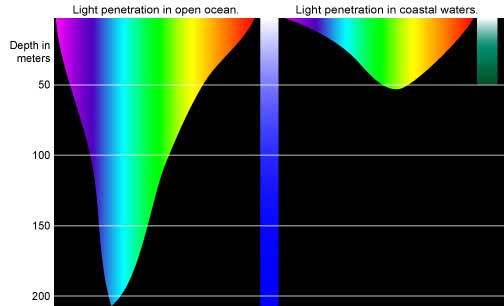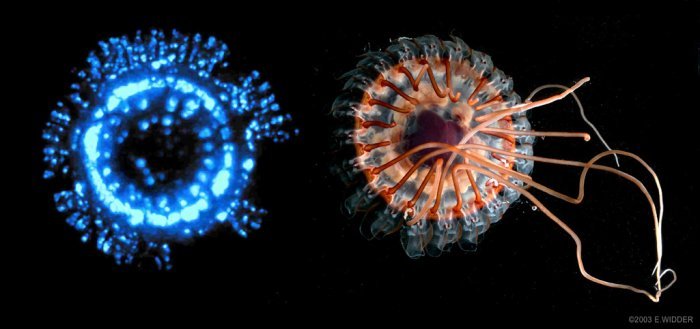Ever wondered why the sky and ocean are blue? But why is water near the coast usually green? And how about animals in the deep, black depths of the sea – what colour are they? Read below for a very basic introduction to bioluminescence, colour and light in the deep sea and find out the answers to these questions. I wrote it during my first year for an elective module in the Colour Science department. Hopefully it’s not written too badly… ^^;.
Bioluminescence and Light in The Deep
Bioluminescence, a form of Chemiluminescence, is simply an organism’s ability to produce light by a chemical reaction. While there are several examples of this phenomenon on land – in certain types of fungus, bacteria or luminous insects, such as the firefly – the ocean harbours many more organisms capable of producing light. This report will examine some of the instances and affects of bioluminescence and light in the deep ocean, within the realms of the little knowledge currently held in this field.

Bioluminescence in a population of dinoflagellates (single-celled algae)
Sunlight decreases in intensity by a factor of 10 approximately for every 75m descent (http://oceanexplorer.noaa.gov/), meaning only a negligible amount of light ever reaches the seabed in much deeper areas. The diagram below shows sunlight attenuation in the photic zone (0-200m) and spectral distribution:

http://oceanexplorer.noaa.gov/
Light penetration in coastal waters is different due primarily to phytoplankton and other matter present, scattering and absorbing light in different ways. The phytoplankton contain chlorophyll, which has optimal absorption at wavelengths 430nm (violet) and 670nm (red) (http://www.oceansonline.com), thus causing coastal waters to appear green
Not only is the intensity of light dramatically reduced as one descends, but the colour is also affected. The molecules in the water absorb longer, lower energy wavelengths such as red light very easily but the shorter, higher energy wavelengths such as blue light are able to penetrate much deeper (the exception being violet light). Blue light is scattered most by the water molecules, giving rise to the general blue colour in the ocean (and also the sky, because such a large part of the atmosphere contains water).
Due to the lack of long wavelength (red) light reaching the deeper waters, the ‘twilight’ zone (200-1000m) is thus home to many organisms with pigments that only reflect red light, causing them to appear black. In contrast, organisms in the photic zone are generally more blue-green, often with light undersides and dark backs to disguise their silhouette to predators. For example, a predator looking down at its prey from above would see the prey’s dark back against the darkness of the depths of the sea. A predator looking up at its prey from below would see the prey’s light underbelly against the sunlight shining around it. In both instances the prey is camouflaged because it has suitable colours to help hide itself in the different light conditions.

Colouration of organisms related to depth
An interesting use of bioluminescence can be seen in the mesopelagic squid. Rather than just having a light-coloured underbelly to reduce silhouetting against the sunlight in shallower waters, the squid uses its photophores (light-producing organs) to counterilluminate the ocean skylight (http://www.lifesci.ucsb.edu/~biolum/). The squid is also temperature-sensitive, turning on blue and green photophores when ascending the cool waters of the evening (as the moonlight has not been filtered to a deep blue colour) and then only blue when descending again as the sun rises.
Virtually no light is able to penetrate below 1000m (the aphotic zone). Most marine organisms at these depths are sensitive only to blue light, which explains why the majority of bioluminescence here is blue itself. From the research of marine scientists such as Dr. Edith Widder, several uses for bioluminescence can be suggested: for defence (to scare off or attract predators, depending on the situation), attracting mates through special flashing patterns or shapes or for luring prey.

Atolla jellyfish and its display of bioluminescence
Perhaps most obviously, it can be used to illuminate the dark of the ocean in search of food. One particular family of fish, the malacosteid family, is able to produce and detect red light (http://www.lifesci.ucsb.edu/~biolum/). Although it doesn’t travel far in the darkness, most other fish aren’t sensitive to the long wavelengths, so it gives the fish a distinct advantage when hunting.
Research into bioluminescence and indeed life in general in the depths of the ocean is still relatively young. The abundance of new species is gratifying, but the tricky part is understanding how life operates at these depths. Certainly, with advancements in technology we can explore for longer and at greater depths and are sure to learn more about the life present there in the world with little light.
**********
Bibliography
Dr. Chamberlin. Light in the Sea, http://www.oceansonline.com/ (accessed 27/11/05)
http://www.oceansonline.com/light_in_the_sea.htm
Haddock, S.H.D.; McDougall, C.M.; Case, J.F. The Bioluminescence Web Page, http://lifesci.ucsb.edu/~biolum/ (created 1997; updated 2005; accessed 27/11/05)
http://www.lifesci.ucsb.edu/~biolum/organism/squid.html
http://www.lifesci.ucsb.edu/~biolum/organism/dragon.html
Harbour Branch Oceanographic Institution. “Welcome to Harbour Branch Oceanographic”, http://www.hboi.edu/ (accessed 27/11/05)
http://www.hboi.edu/marinesci/biolum.html
http://www.biolum.org/ (accessed 27/11/05)
Hart, Stephen. Extreme Beings: How Life Scrounges for Photons, (5th May 2003) http://www.space.com/ in cooperation with http://www.astrobio.net/ (accessed 27/11/05)
http://www.space.com/scienceastronomy/astrobio…
National Oceanic and Atmospheric Administration. NOAA Ocean Explorer, http://oceanexplorer.noaa.gov/ (accessed 27/11/05)
http://oceanexplorer.noaa.gov/explorations/04deepscope/…
http://oceanexplorer.noaa.gov/explorations/02sab/…pdf
http://oceanexplorer.noaa.gov/explorations/04deepscope/…
Page, Michael Le. The light at the bottom of the sea, New Scientist Vol 188 No 2525 (12th November 2005). Reed Business Information Ltd. p48
Woods Hole Oceanographic Institution. Shedding Light on Light in the Ocean, Vol 43, No.2 (2004) http://www.whoi.edu/oceanus/index.do (accessed 27/11/05)
http://www.whoi.edu/cms/files/dfino/2005/4/…pdf









Hello! Wonderful site and wonderful post. Just one thing I must correct you on, if I may. The colour of the sky is not due to water molecules, it is due to the fact that it is mostly nitrogen. Nitrogen tends to scatter blue wavelengths (hence blue sky during the day, but red sunsets due to the blue components being removed by the nitrogen scattering, and also by dust). I’m sorry I forget the precise name of the scattering, I thought it was Rayleigh Scattering but it’s not, it’s a close relative.
Regardless, keep up the great work!
Thank you!
Interesting. When fishing, would a lure with dark bottom and light top increase likelihood of fish striking?
Interesting. When fishing, would a lure with dark bottom and light top increase likelihood of fish striking?
thank you
thank you
in found the open ocen graph
http://oceanexplorer.noaa.gov/explorations/04deepscope/background/deeplight/deeplight.html
but still try to found the costal one
thank you to help me
Hi Philippe. If you click on the image on the Oceanexplorer site, it will show both the deep sea and coastal parts of the image.
Try clicking on the picture on Ocean explorer.
Thanks for reading ^^
in found the open ocen graph
http://oceanexplorer.noaa.gov/explorations/04deepscope/background/deeplight/deeplight.html
but still try to found the costal one
thank you to help me
Hi Philippe. If you click on the image on the Oceanexplorer site, it will show both the deep sea and coastal parts of the image.
Try clicking on the picture on Ocean explorer.
Thanks for reading ^^
hello
thank you for your article
i like to know where did you found the graph
light penetration in open ocean and light penetration in costal water
thank you
philippe.madeira at free.Fr
hello
thank you for your article
i like to know where did you found the graph
light penetration in open ocean and light penetration in costal water
thank you
philippe.madeira at free.Fr
Hi Seo. Thank you for reading.
I’m interested in the article your wife would like to write. Can you tell me a little more about it please and show me the blog she would link from? If it is in a newspaper, you might need to contact the relevant organisations, as I do not own the copyright to the images. Still, please reply here and let me know more ^^
Hi Seo. Thank you for reading.
I’m interested in the article your wife would like to write. Can you tell me a little more about it please and show me the blog she would link from? If it is in a newspaper, you might need to contact the relevant organisations, as I do not own the copyright to the images. Still, please reply here and let me know more ^^
Hey!, thanks for the good “ur in the deep sea” post. My wife works at a local newspaper production in germany and she ask me: Would it be possible, that i can write a story about this post? She would be really happy if she can do this and she will give you a link from a german blog too. Please post me the answer. Greetings Motor
Hey!, thanks for the good “ur in the deep sea” post. My wife works at a local newspaper production in germany and she ask me: Would it be possible, that i can write a story about this post? She would be really happy if she can do this and she will give you a link from a german blog too. Please post me the answer. Greetings Motoröl
You’re welcome! I hope the information is accurate – please check any information you use ^^
You’re welcome! I hope the information is accurate – please check any information you use ^^
Hai Mike,
Thank you for your write. It’s really helpful for me, because I try to find the Light Penetration picture source for my assignment and I found your web including the web of that picture. Thank you.
Hai Mike,
Thank you for your write. It’s really helpful for me, because I try to find the Light Penetration picture source for my assignment and I found your web including the web of that picture. Thank you.